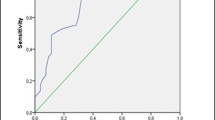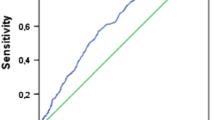Abstract
The incidence of thyroid cancer has been greatly increasing. Several studies aimed to investigate biomarkers for prediction of thyroid cancer. Some of these studies have suggested that thyroid autoantibodies (TAb) could be used as predictors of thyroid cancer risk, but the correlation between TAb and PTC is still a matter of debate. The aim of this study is to evaluate thyroid autoimmunity and TAbs in patients with PTC and benign multinodular goiter (MNG) to investigate if TAbs and autoimmune thyroid disease (ATD) could predict thyroid malignancy. A total of 577 patients with thyroid papillary carcinoma (PTC) and 293 patients with benign MNG disease were enrolled postoperatively. Demographic features, thyroglobulin (TgAb) and thyroid peroxidase antibodies (TPOAb) and histologic outcome of the patients were evaluated. The prevalence of ATD and TgAb or TPOAb measurements was not statistically different in PTC and MNG groups. However, tumors were significantly smaller and tumor capsule invasion was seen less frequently in patients with PTC and ATD than without ATD. Patients without ATD had more advanced stage (TNM stage III/IV) tumors than with ATD. Only one of the 11 patients with distant organ metastasis had ATD. The present study demonstrated that the prevalence of ATD diagnosed even with histology or TAb positivity was not different in patients with PTC and MNG. However, having ATD might be associated with a better prognosis in PTC patients.
Similar content being viewed by others
References
Pellegriti G, Frasca F, Regalbuto C et al (2013) Worldwide increasing incidence of thyroid cancer: update on epidemiology and risk factors. J Cancer Epidemiol 2013:965212 (Epub 7 May 2013)
Verkooijen HM, Fioretta G, Pache JC et al (2003) Diagnostic changes as a reason for the increase in papillary thyroid cancer incidence in Geneva, Switzerland. Cancer Causes Control 14(1):13–17
Kim ES, Lim DJ, Baek KH et al (2010) Thyroglobulin antibody is associated with increased cancer risk in thyroid nodules. Thyroid 20(8):885–891
Fiore E, Rago T, Latrofa F et al (2011) Hashimoto’s thyroiditis is associated with papillary thyroid carcinoma: role of TSH and of treatment with l-thyroxine. Endocr Relat Cancer 18(4):429–437
Caturegli P, De Remigis A, Chuang K et al (2013) Hashimoto’s thyroiditis: celebrating the centennial through the lens of the Johns Hopkins hospital surgical pathology records. Thyroid 23(2):142–150
Chen YK, Lin CL, Cheng FT et al (2013) Cancer risk in patients with Hashimoto’s thyroiditis: a nationwide cohort study. Br J Cancer 109(9):2496–2501
Cunha LL, Morari EC, Guihen AC et al (2012) Infiltration of a mixture of immune cells may be related to good prognosis in patients with differentiated thyroid carcinoma. Clin Endocrinol (Oxf) 77(6):918–925
French JD, Kotnis GR, Said SJ et al (2012) Programmed death-1+ T cells and regulatory T cells are enriched in tumor-involved lymph nodes and associated with aggressive features in papillary thyroid cancer. J Clin Endocrinol Metab 97(6):E934–E943
Qing W, Fang WY, Ye L et al (2012) Density of tumor associated macrophages correlates with lymph node metastasis in papillary thyroid carcinoma. Thyroid 22(9):905–910
Xu WC, Li ZB, Chen YR et al (2011) Expression and distribution of S-100, CD83, and costimulatory molecules (CD80 and CD86) in tissues of thyroid papillary carcinoma. Cancer Invest 29(4):286–292
Yu H, Huang X, Liu X et al (2013) Regulatory T cells and plasmacytoid dendritic cells contribute to the immune escape of papillary thyroid cancer coexisting with multinodular non-toxic goiter. Endocrine 44(1):172–181
Wu X, Lun Y, Jiang H et al (2014) Coexistence of thyroglobulin antibodies and thyroid peroxidase antibodies correlates with elevated thyroid-stimulating hormone level and advanced tumor stage of papillary thyroid cancer. Endocrine 46(3):554–560
Hollowell JG, Staehling NW, Flanders WD et al (2002) Serum TSH, T(4), and thyroid antibodies in the United States population (1988 to 1994): National Health and Nutrition Examination Survey (NHANES III). J Clin Endocrinol Metab 87:489–499
Spencer CA (2011) Clinical review: clinical utility of thyroglobulin antibody (TgAb) measurements for patients with differentiated thyroid cancers (DTC). J Clin Endocrinol Metab 96:3615–3627
Edge SB, Byrd DR, Compton C et al (2010) AJCC cancer staging manual, 7th edn. Springer, New York
Lun Y, Wu X, Xia Q et al (2013) Hashimoto’s thyroiditis as a risk factor of papillary thyroid cancer may improve cancer prognosis. Otolaryngol Head Neck Surg 148:396–402
Wartofsky L (2010) Increasing world incidence of thyroid cancer: increased detection or higher radiation exposure. Hormones 9(2):103–108
Ostroumova E, Brenner A, Oliynyk V et al (2009) Subclinical hypothyroidism after radioiodine exposure: Ukrainian–American cohort study of thyroid cancer and other thyroid diseases after the chornobyl accident (1998–2000). Environ Health Perspect 117(5):745–750
Gomez Segovia I, Gallowitsch HJ, Kresnik E et al (2004) Descriptive epidemiology of thyroid carcinoma in Carinthia, Austria: 1984–2001. Histopathologic features and tumor classification of 734 cases under elevated general iodination of table salt since 1990: population-based age-stratified analysis on thyroid carcinoma incidence. Thyroid 14(4):277–286
Laurberg P, Cerqueira C, Ovesen L et al (2010) Iodine intake as a determinant of thyroid disorders in populations. Best Pract Res 24(1):13–27
Bloodworth JMB, Lechago J, Gould VE (1996) Bloodworth’s endocrine pathology, 3rd edn. Williams & Wilkins, Baltimore
Singh B, Shaha AR, Trivedi H et al (1999) Coexistent Hashimoto’s thyroiditis with papillary thyroid carcinoma: impact on presentation, management, and outcome. Surgery 126(6):1070–1077
Ward LS, Assumpção LV (2007) The impact of gender in differentiated thyroid cancer. Clin Endocrinol 66(5):752–753
Cunha LL, Ferreira RC, Marcello MA et al (2011) Clinical and pathological implications of concurrent autoimmune thyroid disorders and papillary thyroid cancer. J Thyroid Res 17(2011):387062
Boi F, Lai ML, Marziani B et al (2005) High prevalence of suspicious cytology in thyroid nodules associated with positive thyroid autoantibodies. Eur J Endocrinol 153(5):637–642
Fiore E, Rago T, Scutari M et al (2009) Papillary thyroid cancer, although strongly associated with lymphocitic infiltration on histology, is only weakly predicted by serum thyroid autoantibodies in patients with nodular thyroid disease. J Endocrinol Invest 32(4):344–351
Boelaert K, Horacek J, Holder RL et al (2006) Serum thyrotropin concentration as a novel predictor of malignancy in thyroid nodules investigated by fine-needle aspiration. J Clin Endocrinol Metab 91(11):4295–4301
Rago T, Di Coscio G, Ugolini C et al (2007) Clinical features of thyroid autoimmunity are associated with thyroiditis on histology and are not predictive of malignancy in 570 patients with indeterminate nodules on cytology who had a thyroidectomy. Clin Endocrinol (Oxf) 67(3):363–369
Fiore E, Rago T, Provenzaleetal MA et al (2009) Lower levels of TSH are associated with a lower risk of papillary thyroid cancer in patients with thyroid nodular disease: thyroid autonomy may play a protective role. Endocr Relat Cancer 16(4):1251–1260
Jankovic B, Le KT, Hershman JM (2013) Clinical review: Hashimoto’s thyroiditis and papillary thyroid carcinoma: is there a correlation? J Clin Endocrinol Metab 98(2):474–482
Wirtschafter A, Schmidt R, Rosen D et al (1997) Expression of the RET/PTC fusion gene as a marker for papillary carcinoma in Hashimoto’s thyroiditis. Laryngoscope 107(1):95–100
Sheils OM, O’Leary JJ, Uhlmann V et al (2000) Ret/PTC-1 activation in Hashimoto thyroiditis. Int J Surg Pathol 8(3):185–189
Elisei R, Romei C, Vorontsova T et al (2001) RET/PTC rearrangements in thyroid nodules: studies in irradiated and not irradiated, malignant and benign thyroid lesions in children and adults. J Clin Endocrinol Metab 86(7):3211–3216
Guarino V, Castellone MD, Avilla E et al (2010) Thyroid cancer and inflammation. Mol Cell Endocrinol 32(1):94–102
Muzza M, Degl’Innocenti D, Colombo C et al (2010) The tight relationship between papillary thyroid cancer, autoimmunity and inflammation: clinical and molecular studies. Clin Endocrinol 72(5):702–708
Kashima K, Yokoyama S, Noguchi S et al (1998) Chronic thyroiditis as a favorable prognostic factor in papillary thyroid carcinoma. Thyroid 8(3):197–202
Loh KC, Greenspan FS, Dong F et al (1999) Influence of lymphocytic thyroiditis on the prognostic outcome of patients with papillary thyroid carcinoma. J Clin Endocrinol Metab 84(2):458–463
Kim EY, Kim WG, Kim WB et al (2009) Coexistence of chronic lymphocytic thyroiditis is associated with lower recurrence rates in patients with papillary thyroid carcinoma. Clin Endocrinol 71(4):581–586
Gupta S, Patel A, Folstad A et al (2001) Infiltration of differentiated thyroid carcinoma by proliferating lymphocytes is associated with improved disease-free survival for children and young adults. J Clin Endocrinol Metab 86(3):1346–1354
Medenica S, Radojevic N, Stojkovic M et al (2015) Autoimmunity and thyrotropin level in developing thyroid malignancy. Eur Rev Med Pharmacol Sci 19(15):2824–2829
Yano Y, Shibuya H, Kitagawa W et al (2007) Recent outcome of grave’s disease patients with papillary thyroid cancer. Eur J Endocrinol 157(3):325–329
Kim HS, Choi YJ, Yun JS (2010) Features of papillary thyroid microcarcinoma in the presence and absence of lymphocytic thyroiditis. Endocr Pathol 21(3):149–153
Sakorafas GH, Giotakis J, Stafyla V (2005) Papillary thyroid microcarcinoma: a surgical perspective. Cancer Treat Rev 31(6):423–438
Falvo L, D’Ercole C, Sorrenti S et al (2003) Papillary microcarcinoma of the thyroid gland: analysis of prognostic factors including histological subtype. Eur J Surg Suppl 588:28–32
Author information
Authors and Affiliations
Corresponding author
Ethics declarations
Conflict of interest
The authors declare no conflicts of interest that could be perceived as prejudicing the impartiality of this research.
Ethical approval
The study protocol was approved by the local ethics committee, and the informed consent was obtained from all individual participants included in the study.
Rights and permissions
About this article
Cite this article
Selek, A., Cetinarslan, B., Tarkun, I. et al. Thyroid autoimmunity: is really associated with papillary thyroid carcinoma?. Eur Arch Otorhinolaryngol 274, 1677–1681 (2017). https://doi.org/10.1007/s00405-016-4414-6
Received:
Accepted:
Published:
Issue Date:
DOI: https://doi.org/10.1007/s00405-016-4414-6




